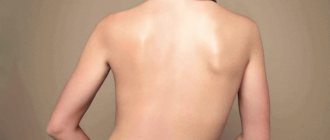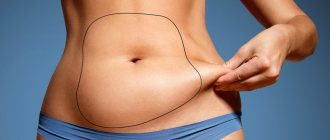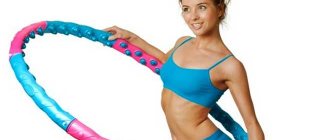- home
- general surgery
- Diastasis of the rectus abdominis muscles
Laparoscopic correction of diastasis of the rectus muscles of the abdominal wall
The rectus abdominis muscles are connected to each other by a narrow plate, which is formed by the interweaving of light-colored tendon fibers - hence the name “white” line of the abdomen. Diastasis is its expansion as a result of pressure, with the divergence of the rectus abdominis muscles occurring. The disease manifests itself as a protrusion along the midline of the abdomen, shaped like a roller that appears when tense. This pathology is quite common and is diagnosed in 0.5-1% of patients.
Who gets diastasis?
More often, this disease is diagnosed in women; as a rule, expansion - diastasis of the rectus abdominis muscles - develops during pregnancy, 2-3 months after childbirth. During pregnancy, under the influence of an altered normal background, connective tissue becomes looser - this occurs to ensure normal labor activity. The tissue structure is restored only after 8-12 months. But, if a woman starts training in the gym early to correct her stomach, diastasis of the rectus muscles appears. Thus, intense physical activity during the postpartum period can lead to the formation of diastasis. Men also suffer from this pathology, which occurs with heavy physical activity or obesity.
Types of abdomen
You are successful in your work and personal life, but despite this, it seems to you that you are not trying hard enough, that you have not achieved everything you could. Such people are called perfectionists, and of all types of belly fat, they most often get the “stressed” type.
Perfectionists live in a state of permanent stress, because they need to rush to be the first, the best, and unsurpassed in everything they do. This leads to frequent skipping meals, snacking on the run, and excessive coffee consumption. The result is irritable bowel syndrome, bloating and other digestive problems.
Your belly belongs to this type if extra pounds tend to be deposited in the subcutaneous tissue around the umbilical area and in the omentum - inside the abdominal cavity. The body “stores” fat in this way under the influence of the hormone cortisol, which is produced in excess during stress. To make sure that the described type of abdomen is your case, place your palm on the navel area. You will feel that your belly is elastic and firm, rather than soft and jelly-like. This kind of belly is more common among men; it is called a “beer belly” - it is dense, elastic, poorly retracted and provocatively protrudes forward, like a poured watermelon.
Of course, we must not forget about that category of female representatives who, for genetically determined reasons, generally store fat only on the stomach, and have never had a thin waist.
Strategy and tactics:
- Try to reduce your stress levels. To do this, first of all, you need to normalize your sleep. After all, with a lack of sleep, a hormonal imbalance inevitably occurs in the female body, as a result of which metabolism is disrupted and a deficiency of vital energy occurs. The body strives to make up for this deficiency, which often results in overeating and insatiable consumption of sweets.
- You are shown yoga classes and meditative practices. A warm bath before bed will also have a relaxing effect. Add a few drops of lavender, lemon balm or ylang-ylang essential oil to the water to enhance the effect of the treatment.
- Do not overuse coffee - two cups a day is enough.
- Reduce the amount of food consumed at one time to 250 - 300 grams.
- Avoid strenuous physical activity. Exercising with barbells and dumbbells is not at all what you need. Better take regular walks in the fresh air and give preference to aerobic exercise.
Often this type of abdomen appears in women after childbirth. In some cases, during pregnancy, the rectus abdominis muscles move away from each other under pressure and do not return to their original position even several months after birth. As a result, a protrusion occurs in the abdominal area, which cannot be eliminated either through diet or exercise. However, even such a serious cosmetic flaw is not a reason for despair. After all, the technique of mini-abdominoplasty and traditional abdominoplasty has been worked out by doctors to the smallest detail. A qualified specialist can easily eliminate the discrepancy of the aponeurosis, and, if necessary, form a neo-umbilicus (perform umbilicoplasty).
Causes
Thus, as a result of thinning and stretching of the linea alba, the muscles stretch and diverge. The cause of this condition may be:
- pregnancy and childbirth;
- unjustified physical stress, chronic constipation, prolonged and strained cough, etc. - conditions leading to increased intra-abdominal pressure;
- obesity or rapid loss of body weight, leading to decreased muscle tone;
- congenital weakness of connective tissue; Often this condition is accompanied by hernias of the anterior abdominal wall of various locations.
It should be noted that in most cases, in women after the birth of a child, the rectus abdominis muscles contract within 2 months and converge back to the center. However, the initial state is not always achieved, for example, with weakened abdominal muscles, with a large degree of distension, with repeated pregnancies or congenital connective tissue dysplasia.
What can cause your stomach to bulge?
There are several main reasons why the lower abdomen may bulge:
- lordotic type of posture, when the deflection in the lumbar spine is excessive, this leads to spasms in the back muscles and loss of abdominal tone;
- prolapse (drooping) of internal organs, caused, in particular, by hypotonicity (low muscle tone) of the press;
- weakness of the pelvic floor muscles;
Photo: istockphoto.com
- chronic constipation, oddly enough, occurs even among adherents of a healthy diet,
- may appear for psychosomatic reasons;
- diastasis of the abdominal muscles, which is not always obvious (when the distance between the rectus abdominis muscles increases and the stomach becomes round).
How to get a flat stomach without training?
How to determine diastasis
To check for the presence of diastasis of the white line of the abdomen, you should perform a simple test. The patient, lying on his back, should bend his knees and place his feet on the floor. Next, bend your neck and slightly tense your abdominal muscles; To do this, just rise a little. Use your fingers to explore the navel and midline area. The appearance of a roller-like protrusion along the midline of the abdomen with smooth contours indicates pathology. It is a little more difficult to identify the disease in people who are obese. More accurate information can be obtained using ultrasound of the anterior abdominal wall.
To determine the stage of diastasis and indications for surgery, as well as to choose the correct surgical treatment tactics, you need to send me a photo of the abdomen in frontal and lateral projection in an inflated and calm state (can be taken with a phone) to my personal email address. Optimally, a complete description of the ultrasound of the abdominal cavity and anterior abdominal wall, preferably an examination by a surgeon, indicate age and main complaints. Then I will be able to give a more accurate answer to your situation.
Stage I
- expansion of the white line in the navel area up to 3 cm.
Stage II
- discrepancy reaches 3-6 cm.
Stage III
- characterized by a diastasis of more than 6 cm.
"Water" belly
Water retention in the body occurs due to the accumulation of fluid in any part of the body. In this case we are talking about the stomach. Fluid accumulation is also one of the ways our body responds to stress.
.
A water belly can also be caused by an electrolyte imbalance. The most obvious example of water retention in the body is swelling of the arms and legs, but it can also happen to your stomach.
Most often, bloating due to water retention is temporary, and the body regains balance after the stressful situation passes.
However, in rare cases, swelling in the abdominal area may indicate cardiac, pulmonary, or kidney complications.
What to do?
- Monitor your weight and watch for drastic changes.
- Avoid consumption foods high in salt
, since salt promotes further water retention.
- Drink more water
. Although it seems counterintuitive, drinking enough water helps remove accumulated fluid in the body.
- Eat foods that have diuretic properties: green and black tea, parsley, watermelon and ginger.
- Lift up legs up
, lying on your back 3-4 times a day to improve blood and fluid circulation.
Stages of the disease
The distance between the rectus muscles is normally only 0.5-2 cm. The severity of the disease (its stage) is indicated by the size of the divergence of the rectus muscles, measured in the middle between the navel and the xiphoid process of the sternum. There are three stages of the disease:
- Stage I - expansion of the white line in the navel area up to 3 cm. This defect does not affect the shape of the abdomen. As a rule, it occurs in women after their first birth. Signs of diastasis of the rectus abdominis muscles at this stage are dull, low-intensity pain in the epigastrium, nausea, constipation, and bloating. Often the patient experiences difficulty walking.
- Stage II - the discrepancy reaches 3-6 cm. At this stage, relaxation of the lateral muscle groups and the formation of an umbilical hernia are noted.
- Stage III - this stage of the disease is characterized by a diastasis of more than 6 cm. At this stage, hernias (umbilical and linea alba) are not uncommon. In addition to a saggy belly, the patient is concerned about more serious disorders. Muscle atrophy and splanchnoptosis develop—displacement of the abdominal organs, accompanied by various disorders. The working capacity of such patients is limited.
When will exercise help?
However, at the initial stage in women after childbirth (in the first months), significant improvement can be achieved without surgical treatment. It should be noted that if you have diastasis, you should not prescribe physical exercises on the abs, optimally - swimming pool, walking, running. There is also a set of special exercises, which include simple movements, which a specialist in physical therapy will help you choose. It should be noted that lifting the legs and body in a lying position should be avoided. In advanced cases, as well as a year after childbirth, exercises for diastasis of the rectus abdominis muscles will no longer bring the expected result. In such a situation, correction of the stretched abdominal line is necessary.
When to see a surgeon
It should be understood that diastasis will not disappear on its own; moreover, the course of the disease is progressive.
In advanced forms of the disease, quite dangerous disorders often develop. For example, a hernia can form at any time, the infringement of which can lead to the development of hazardous health consequences. In addition, with diastasis of II-III degree, the area of disturbances is quite impressive, which affects the scope of surgical intervention. Often, diastasis of the rectus muscles is accompanied by ptosis of the anterior abdominal wall and the presence of ventral hernias of different localization. There may be additional cosmetic problems: post-operative scars or postpartum stretch marks. The surgeon is obliged to take into account all anatomical changes in this area and the cosmetic wishes of the patient. In such a situation, the effect of the operation will be maximum.
Patent. Method of Lipoabdominoplasty with navel relocation
Unexpected reason
When the stomach protrudes and hangs strongly, sometimes it visually seems that the legs are growing from it. What is the reason for this physiological “effect”?
Traditionally, overeating is considered the cause of a hanging belly. But this is far from the truth.
The stomach can stick out and hang in very thin people, because they do not have fat layers to support the insides.
The position of the abdomen does not depend on its size. He may be big, but he is fit.
The main reason for a protruding belly is prolapse of internal organs. The position of the internal organs is determined by two factors: internal and external.
Article on the topic Lush breasts, perfect abs. Do miracle devices from the Internet help?
The internal factor (main) is the ligaments that suspend the viscera to the posterior wall of the abdominal cavity, primarily to the spine. A person can influence them independently only with the help of special exercises.
The external factor is the muscles of the anterior abdominal wall and pelvic floor. Everyone can keep them in good condition by performing special abdominal exercises (with the exception of raising the torso or legs while lying down), training the pelvic diaphragm, and simply maintaining physical activity.
Main types of operations
The goal of surgical treatment is to eliminate diastasis and strengthen this area of the abdominal wall. The result is a good functional and cosmetic effect.
Currently there are:
- tension plasty with local tissues - during the operation, structures are created from tissue of the anterior abdominal wall, which we currently do not use in our practice, due to the large number of relapses and lack of cosmetic effect (incision on the abdominal wall is 16-18 cm);
- non-tension plastic surgery using a mesh endoprosthesis. A mesh made of synthetic material completely covers the diastasis area, being fixed along the edge. The downside is that the lack of alignment of the rectus muscles does not lead to a good cosmetic effect during abdominal wall reconstruction.
- tension plasty with suturing of diastasis and additional use of a mesh endoprosthesis. The diastasis is sutured and the plastic site is additionally strengthened with a mesh implant. A mesh made of synthetic material completely covers the area of the sutured diastasis, additionally secured along the edge with suture material. After 2 months, the prosthesis grows into connective tissue, forming a single anatomical complex. Subsequently, it turns into a durable connective tissue structure up to 2 mm thick, which can withstand quite heavy loads. This plastic surgery allows to reduce relapses to 1%, instead of 20% during plastic surgery using tension approaches without an implant.
- tension plasty with suturing of diastasis using a mesh endoprosthesis and abdominoplasty. This operation is performed for diastasis, which is accompanied by ptosis of the anterior abdominal wall, the presence of ventral hernias of different locations, cosmetic problems - postoperative scars or postpartum stretch marks.
Today, various types of plastic surgery with a mesh implant for diastasis of the rectus abdominis muscles can be performed either openly or using endoscopic equipment through a small incision in the umbilical area or punctures of the abdominal wall - laparoscopically.
Endoscopic hernioplasty for diastasis of the rectus muscles has a number of advantages:
- absence of pain syndrome;
- minimal risk of disease relapse (less than 1%);
- no visible scars;
- shorter rehabilitation period.
There is no single way to correct abdominal wall diastasis. In each specific case, everything is decided individually, based on the stage of the disease, associated cosmetic problems and the woman’s wishes. I have extensive experience (more than 400 operations) in various methods of correcting diastasis in difficult situations, so I can solve the problems of every woman with this disease.
The use of the latest technologies in medicine, modern equipment, ultra-thin suture materials and mesh implants guarantee high quality surgical interventions. At the same time, the risk of postoperative complications or relapses is minimized. However, one more important factor should be taken into account - if any pathological disorders appear, contacting a doctor earlier significantly affects the result of treatment.










